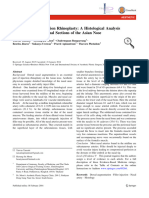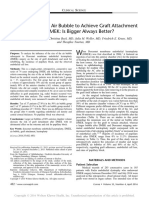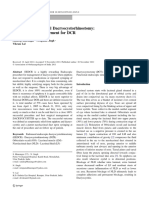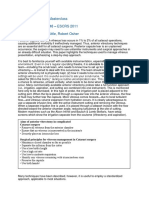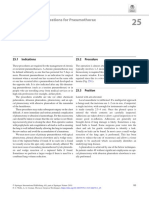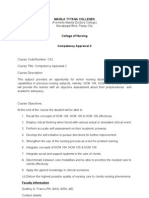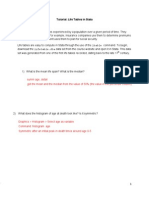Big Bubble 2002 Anwar
Big Bubble 2002 Anwar
Uploaded by
Joseph Chipana GutierrezCopyright:
Available Formats
Big Bubble 2002 Anwar
Big Bubble 2002 Anwar
Uploaded by
Joseph Chipana GutierrezCopyright
Available Formats
Share this document
Did you find this document useful?
Is this content inappropriate?
Copyright:
Available Formats
Big Bubble 2002 Anwar
Big Bubble 2002 Anwar
Uploaded by
Joseph Chipana GutierrezCopyright:
Available Formats
techniques
Big-bubble technique to bare
Descemet’s membrane in anterior
lamellar keratoplasty
Mohammed Anwar, FRCS, Klaus D. Teichmann, MD
ABSTRACT
We describe a lamellar keratoplasty technique to bare Descemet’s membrane in which air
is injected to detach the central Descemet’s. After a partial-thickness corneal trephination
is performed, a disposable needle is inserted, deeply and bevel down, into the paracentral
corneal stroma and air is injected. In most cases, this forms a large air bubble between
Descemet’s membrane and the corneal stroma. After anterior lamellar keratectomy is
performed, a small opening is made in the air bubble and the remaining stromal layers are
lifted with an iris spatula, severed with a blade, and excised with scissors. This technique
is faster, safer, and easier to perform than previous methods. J Cataract Refract Surg
2002; 28:398 – 403 © 2002 ASCRS and ESCRS
in a high proportion of cases.7,8,10 The crucial step,
L amellar keratoplasty (LKP) was developed more
than 150 years ago.1 The first attempt to dissect
near Descemet’s membrane was by Hallermann.2 An-
namely gaining access to the tissue plane immediately
anterior to Descemet’s membrane (the pre-Descemet’s
war3 and Archila4 were the first to describe complete anatomic and potential surgical plane), presented the
baring of Descemet’s membrane in the recipient cornea. major difficulty in preparing an extremely deep lamellar
This technique promised to result in less interface opac- bed6 and thus in performing maximum-depth anterior
ity and hence improved visual acuity postoperatively, LKP.11
yielding vision comparable to that resulting from pene- We present a technique that facilitates exposure of
trating keratoplasty (PKP). However, few surgeons con- Descemet’s membrane, considerably shortens the dura-
tinued pursuing this goal5–12 because the rate of tion of the operation, lowers the risk of perforation, and
intraoperative perforation was high (39.2%)10 when has the potential to make maximum-depth LKP a pop-
one attempted to remove all corneal stroma. In addition, ular procedure.
failure to bare Descemet’s membrane was the outcome
Accepted for publication September 11, 2001. Surgical Technique
From El Maghrabi Eye & Ear Hospital, Jeddah (Anwar), and King Partial-thickness trephination of the cornea is per-
Khaled Eye Specialist Hospital, Riyadh (Teichmann), Saudi Arabia.
formed to a depth between 60% and 80% using a cali-
Neither author has a financial or proprietary interest in any material or
method mentioned.
brated guided trephine system (Krumeich, Rhein
Medical) that can be set to any depth. The Hanna suc-
Reprint requests to Klaus D. Teichmann, MD, Chief of Anterior Seg-
ment, King Khaled Eye Specialist Hospital, PO Box 7191, Riyadh 11 tion trephine (Moria) is also accurate but can be set in
462, Saudi Arabia. E-mail: kdt_it@hotmail.com. 100 m steps only. The Hessburg-Barron vacuum tre-
© 2002 ASCRS and ESCRS 0886-3350/02/$–see front matter
Published by Elsevier Science Inc. PII S0886-3350(01)01181-6
TECHNIQUES: ANWAR
phine (Jedmed Instrument Co., Katena Products Inc.) is
less precise13 but easy to use and disposable.
A convenient point in the circumference of the cut
is chosen as the entry site for the needle. If the trephine
groove at this site is too shallow, manual deepening is
performed.
A 27- or 30-gauge needle is attached to a 1 to 3 mL
air-filled syringe. The needle is bent approximately
5.0 mm from its tip so that the terminal segment angles
up approximately 60 degrees while the bevel faces down.
The tip is introduced, bevel down, into the central cor-
neal stroma at the chosen entry site, deep in the trephi-
nation groove. Figure 1. (Anwar) A 27-gauge needle is positioned bevel down in
the paracentral area.
Under direct visual control, the needle is carefully
advanced into the partially severed central button, aim-
ing in a direction halfway between a tangential and a
radial one until the bevel is completely buried (Figure 1).
In general, the tip of the needle reaches about 3.0 to
4.0 mm from the entry point in the trephination groove.
The oblique direction of advancement avoids the central
part of the cornea, which is usually the thinnest area,
particularly in keratoconus. The bevel of the needle is
kept strictly facing posteriorly so that the risk of punc-
turing Descemet’s membrane is reduced and air entry
into the pre-Descemet’s plane is encouraged.
The plunger of the air-filled syringe is pressed until
an effect is noted. This takes 1 of 2 forms. Most com-
Figure 2. (Anwar) A white, semiopaque disk with a near-circular
monly, after initially infiltrating part of the central cor- outline develops after air injection. This indicates the formation of a big
neal disk, the air suddenly forms a large bubble with a bubble, which detaches the central Descemet’s membrane, even
more or less circular outline between Descemet’s mem- though the bubble is not visible.
brane and the deepest stroma (ie, in the pre-Descemet’s
plane). This is the desired result and is indicated by the air from entering the anterior chamber through the tra-
sudden easing of resistance of the plunger of the syringe becular meshwork.8
as well as the “explosive” appearance of a white, semi- The aim should always be to achieve a large bubble.
opaque disk (Figure 2). The edge of the disk may, but If the first attempt yields a local, fuzzy region of white
usually does not, coincide exactly with the trephination opaque cornea, air injection is stopped, the needle is
groove. The size of the bubble depends on the amount of withdrawn, and the surgeon may repeat the procedure,
air injected. Pressure on the plunger is immediately re- starting at another point on the perimeter of the tre-
leased, and the needle is withdrawn. phine groove where the cornea is still relatively clear.
Less frequently, the air keeps infiltrating the central The needle tip should be visible at all times to avoid
corneal disk without a discernible bubble appearing. In perforation. As each attempt leaves a part of the button
this case, the somewhat denser white opacity lacks the opaque, more than 3 or 4 tries are usually not possible.
sharp, circular outline of the bubble. By the time the air When a big bubble does form, the appearance is unmis-
extends peripherally to the trephine groove, bubble for- takable (Figure 2)
mation is unlikely and the surgeon should stop injecting If a large bubble is not generated even with addi-
air. This preserves some areas of clear corneal tissue (ie, tional air injections, an anterior lamellar keratectomy
in regions where the air has not penetrated) and prevents can be performed in the traditional manner. The re-
J CATARACT REFRACT SURG—VOL 28, MARCH 2002 399
TECHNIQUES: ANWAR
Figure 3. (Anwar) After the anterior stroma is removed by partial Figure 4. (Anwar) Moments after the incision in the bubble, air
keratectomy, a small incision is made in the anterior wall of the big air escapes and the bubble collapses, as indicated by darkening of the
bubble. disk-shaped opacity.
maining stroma is then hydrated and considerably thick- turely. If possible, the opening should be made large
ened by injecting balanced salt solution (BSS威) via a enough so that later, it can be easily identified and a wire
blunt cannula as described by Sugita and Kondo.10 After spatula inserted. If air escapes from the bubble, however,
a few moments, the initially white cornea becomes semi- the knife must be immediately withdrawn, even if the
transparent and further attempts to create a big air bub- opening is not yet large enough.
ble can be performed as described above, with some Collapse of the big air bubble is indicated by sudden
chance of success. darkening of the disk-shaped opacity (Figure 4). At this
When a big bubble is generated, a paracentesis is point, the eye may be softened further by draining more
performed at a site peripheral to the edge of the large air fluid from the paracentesis.
bubble, but no fluid is drained at this stage. The surgeon An Anwar spatula formed like a blunt wire (K3–
should be very careful not to broach the big bubble when 2310, Katena Products Inc.) is inserted through the tiny
doing the paracentesis. If it collapses prematurely, entry opening made by the sharp-tipped knife. The spatula is
into the pre-Descemet’s plane will be more difficult. carefully advanced in the cleavage plane that was created
A partial-thickness anterior keratectomy is then per- by the air until its tip approaches the trephination
formed by dissecting with a #69 Beaver blade (Becton groove. Although the spatula is in direct contact with
Dickinson & Co.), leaving a layer of corneal stroma in Descemet’s membrane, the risk of perforation is mini-
place anterior to the air bubble. (When a big bubble is mal as it is blunt and does not directly push against the
achieved only after a keratectomy is made, no additional membrane.
stromal tissue need be removed.) After the keratectomy The spatula is held steadily and firmly while it is
is completed, some intraocular fluid is drained through gently lifted anteriorly, slightly tenting the residual stro-
the paracentesis. However, for good optical control, the mal layers. The layers are incised by filing or rubbing
surgical field is kept dry. with a #69 Beaver blade (Figure 5). The spatula can also
With the sharp tip of a pointed blade (eg, 30-degree be scraped with a sharp knife (eg, Alcon 30-degree oph-
Alcon ophthalmic knife) held almost parallel to the sur- thalmic knife) held parallel to the spatula. Any semi-
face, the remaining layers of corneal stroma are pene- sharp tool such as a round, rotating smooth burr can be
trated near the center of the cornea (Figure 3). Under used; however, this seems to exert more pull on the
direct visual control, the knife tip is carefully advanced, collagen fibers and has a tendency to suddenly slip off
entering the big air bubble in a nearly tangential manner the spatula in an uncontrolled manner.
and creating a small nick in the stromal layers. The sur- The abraded “cut” can extend from the spatula’s
geon attempts to keep holding the knife in 1 plane; if it point of entry into the bubble to near its tip. It opens a
is tilted after entering the bubble, air may escape prema- line of entry into the pre-Descemet’s plane (Figure 6)
400 J CATARACT REFRACT SURG—VOL 28, MARCH 2002
TECHNIQUES: ANWAR
Figure 5. (Anwar) An iris spatula is introduced into the space left by Figure 6. (Anwar) Two slits are made in the anterior wall of the
the collapsed bubble through the opening made by the point of the collapsed bubble by rubbing, or filing, over the spatula as shown in
knife. The overlying stromal fibers are severed by rubbing over the Figure 5.
spatula with the sharp edge of a Beaver blade.
Figure 7. (Anwar) The deepest stromal layers can usually be lifted Figure 8. (Anwar) The donor button is prepared by stripping Des-
off Descemet’s membrane and safely excised using blunt-tipped scis- cemet’s membrane and endothelium.
sors. The exposed Descemet’s membrane is repeatedly moistened
with a wet Weck-Cel sponge.
without requiring introduction of a sharp tool in the cised with a blunt-tipped microscissors (18010, Moria).
immediate vicinity of Descemet’s membrane. However, The air bubble has opened this plane, so no firm adhe-
when the spatula is rubbed with the Beaver blade, care sions remain, although there may be slight stickiness
must be taken to ensure that the spatula does not inad- from drying tissue fluids. Eventually, the cut proceeds
vertently slide outside the previously detached region as along the line of the trephination groove or just central
the spatula tip may perforate Descemet’s membrane. to it. While the circular excision gradually bares increas-
The maneuver can be repeated in other directions, either ingly larger areas of Descemet’s membrane, the structure
at a 180-degree angle or in any other radial direction, to is repeatedly moistened by gentle application of a Weck-
enlarge Descemet’s membrane exposure. The corneal Cel sponge soaked in BSS to keep it from drying under
stromal layers are kept dry at all times to facilitate visual the operating microscope lights (Figure 7). The corneal
control of the ensuing dissection. stroma is kept dry until the excision is complete.
When 1 or more cuts into the remaining stroma are Finally, the corneal donor button is stripped of Des-
completed, the deepest stromal layers are circularly ex- cemet’s membrane and endothelium (Figure 8) and su-
J CATARACT REFRACT SURG—VOL 28, MARCH 2002 401
TECHNIQUES: ANWAR
tured onto the bare Descemet’s membrane in the eye. nique called near-full-thickness dissection. When firm
This prevents wrinkling of the donor Descemet’s mem- scars extend to Descemet’s membrane, baring the mem-
brane at the interface. In many cases, the 2 layers can be brane is not possible or is very hazardous, and perfora-
detached from the graft in 1 piece. The edge of the tion is a likely outcome.
corneal button is firmly seized with a fine-toothed for-
ceps, with the surgeon attempting to grasp most of the Results
corneal stroma but not Descemet’s membrane and en- In 181 cases of keratoconus, an intraoperative per-
dothelium. A dry Weck-Cel sponge is applied near the foration occurred in 16 eyes (9%). In 1 case, the proce-
forceps, at the inner edge of the button, to dislodge the dure was converted to PKP.
innermost layers from the stroma by gently pulling cen-
trally until a small area is detached. This detachment is
Discussion
extended by further pulling with the Weck-Cel sponge
or using a tying (nontoothed) forceps. If the peeling One of us (M.A.) discovered that stromal air injec-
layers tear, each piece is removed separately. Some grafts tion sometimes creates localized detachment of Desce-
do not yield to this technique. When the attachment met’s membrane. This greatly facilitated baring of
between Descemet’s membrane and deep stroma is very Descemet’s membrane, so a method was developed and
firm, vigorous rubbing with dry Weck-Cel sponges tears continuously refined until a big air bubble could be
the inner membranes and the layers are removed piece- achieved in nearly all cases.
meal. This has the disadvantage of leaving roughened Initially, air injection into the corneal stroma was
stromal areas. proposed by Archila.4 Later, it was used by Price,7 Chau
In our experience, a big air bubble can be created in and coauthors,8 and Morris and coauthors.14 All in-
80% to 90% of cases. If all attempts to form a bubble jected air before the partial-thickness trephination.
fail, baring Descemet’s membrane is more tedious, time Morris and coauthors14 also report cleaving Descemet’s
consuming, and hazardous. In such cases, an initial an- membrane from stroma by injecting air. They did not,
terior lamellar keratectomy is made. The Katena spatula however, reach this goal consistently, perhaps as a result
is inserted in a cornea-parallel plane at the bottom of of several aspects of their technique. Specifically, they
the trephine cut and carefully moved forward in a injected air before doing the trephination. The needle
probing manner. When a portion of stroma is under- was not advanced deep enough in the stroma, nor was it
mined in this way, it is incised over the spatula using introduced bevel down. Entry of air into the anterior
the method described above; then it is excised. The pro- chamber, which was common, may have hampered the
cess is repeated and stroma removed layer by layer. In- formation of a large central Descemet’s detachment.
traoperative perforations can usually be managed by Sugita and Kondo10 injected saline to facilitate dis-
intracameral air injection, and conversion to PKP may section but also did not try to create a large, central
be required. Descemet’s detachment. They did, however, pioneer the
use of a fine spatula to help separate Descemet’s mem-
Indications and Precautions brane from stroma. Others15,16 have injected viscoelas-
Optical LKP requires a functioning endothelium. tic substances for this purpose and report success in a
The techniques described work best in cases of kerato- small number of cases, but with a significant risk of
conus, stromal corneal dystrophies, and corneal scars perforation.16 The intracorneal depth location method
that do not reach Descemet’s membrane. If there is a developed by Melles and coauthors17 could prove useful
history of hydrops, air injection into the deep stroma during the advancement of the sharp, disposable needle
invariably leads to entry of air into the anterior chamber before air injection, especially for less experienced sur-
through the break(s) in Descemet’s membrane; a big geons. We have not used this technique yet because we
bubble will fail to form. In these cases, air injection is not want to avoid making a paracentesis before injecting the
advisable and complete baring of Descemet’s membrane air into the stroma. The presence of a paracentesis can
is not possible. Some stroma must be left behind to cover shunt air into the anterior chamber instead of creating a
the area of the ruptured Descemet’s membrane, a tech- big bubble.
402 J CATARACT REFRACT SURG—VOL 28, MARCH 2002
TECHNIQUES: ANWAR
We have used the big-bubble method for more than ausländischen gesamten Medizin. Leipzig, Otto Wigand,
2 years, during which the technique has been continu- 1842; 267–268
ally refined. Used in the manner described here, it rep- 2. Hallermann W. Verschiedenes über Keratoplastik. Klin
Monatsbl Augenheilkd 1959; 135:252–259
resents a reliable, safe way to gain access to the pre- 3. Anwar M. Technique in lamellar keratoplasty. Trans
Descemet’s plane, making wide exposure of Descemet’s Ophthalmol Soc UK 1974; 94:163–171
membrane a realistic goal. 4. Archila EA. Deep lamellar keratoplasty dissection of host
Lamellar keratoplasty has many advantages over tissue with intrastromal air injection. Cornea 1984 –5;
PKP. These include maintenance of globe integrity, the 3:217–218
possibility of using older graft material, a significant re- 5. Amayem AF, Anwar M. Fluid lamellar keratoplasty in
keratoconus. Ophthalmology 2000; 107:76 –79; discus-
duction in quantity and duration of postoperative ste- sion by PR Laibson, 80
roid therapy, nearly complete absence of graft rejection, 6. Naumann GOH, Sautter H. Chirurgie der Kornea. In:
and a low rate of acute and chronic endothelial cell Mackensen G, Neubauer H, eds, Augenärztliche Opera-
loss.10,14 The full benefits of LKP will be realized only tionen. Berlin, Heidelberg, Springer, 1988; vol 1:508
with long-term follow-up. 7. Price FW Jr. Air lamellar keratoplasty. Refract Corneal
Although there is a learning curve for surgeons em- Surg 1989; 5:240 –243
8. Chau GK, Dilly SA, Sheard CE, Rostron CK. Deep la-
barking on this technique, major problems should not mellar keratoplasty on air with lyophilised tissue. Br J
be encountered. If the surgeon fails to achieve a big Ophthalmol 1992; 76:646 – 650
bubble, he or she is left with a cornea that has been 9. Sugita J, Kondo J. [Lamellar keratoplasty and deep lamel-
subjected to stromal air injection.4,8,14 Rupture of Des- lar keratoplasty]. [Japanese] Folia Ophthalmol Jpn 1994;
cemet’s membrane has been described with forceful in- 45:1–3
jection of viscoelastic material16 and might also occur 10. Sugita J, Kondo J. Deep lamellar keratoplasty with com-
plete removal of pathological stroma for vision improve-
with air injection. We have not observed this. Perfora- ment. Br J Ophthalmol 1997; 81:184 –188
tion of the cornea during insertion of the needle is an- 11. Teichmann KD. Lamellar keratoplasty—a comeback?
other possible complication that rules out generating a Middle East J Ophthalmol 1999; 7:59 – 60
big bubble but does not preclude completing a success- 12. Tsubota K, Kaido M, Monden Y, et al. A new surgical tech-
ful near-Descemet’s membrane dissection by other nique for deep lamellar keratoplasty with single running su-
means. Our overall rate of perforation, even including ture adjustment. Am J Ophthalmol 1998; 126:1– 8
13. Schor P, Rocha E, Cheema DP, Miller D. Calibration of
surgeries during the learning curve and development trephine blade depth. J Refract Surg 1997; 13:89 –90
phase, is significantly lower than that previously report- 14. Morris E, Kirwan JF, Sujatha S, Rostron CK. Corneal
ed.10 Preliminary visual results appear comparable to endothelial specular microscopy following deep lamellar
those of PKP performed in Saudi Arabia.18,19 Because keratoplasty with lyophilised tissue. Eye 1998; 12:619 –
Descemet’s membrane and endothelium are removed 622
from the donor button, there is no visible wrinkling and 15. Manche EE, Holland GN, Maloney RK. Deep lamellar
keratoplasty using viscoelastic dissection. Arch Ophthal-
interface haze is minimal or absent. The striae in the host mol 1999; 117:1561–1565
Descemet’s membrane seen in eyes with keratoconus 16. Melles GRJ, Remeijer L, Geerards AJM, Beekhuis WH.
tend to fade over time. A quick surgical technique for deep, anterior lamellar
In conclusion, baring Descemet’s membrane by re- keratoplasty using visco-dissection. Cornea 2000;
moving all corneal stroma in the recipient bed combines 19:427– 432
the advantages of PKP and LKP while avoiding the dis- 17. Melles GRJ, Rietveld FJR, Beekhuis WH, Binder PS. A
technique to visualize corneal incision and lamellar dis-
advantages of both. The big-bubble technique is a sig- section depth during surgery. Cornea 1999; 18:80 – 86
nificant advance in realizing this goal. 18. Mahmood MA, Wagoner MD. Penetrating keratoplasty
in eyes with keratoconus and vernal keratoconjunctivitis.
Cornea 2000; 19:468 – 470
References 19. Mahmood MA, Wagoner MD. Penetrating keratoplasty
1. Mühlbauer FX. Ueber Transplantation der Cornea; Gek- for keratoconus: long-term results in 38 eyes with and
rönte Preisschrift. München, Jos. Lindauer, 1840. (ab- 202 eyes without vernal keratoconjunctivitis. Middle
stract) In: Schmidt CC, ed, Jahrbücher der in und East J Ophthalmol 1999; 7:26 –35
J CATARACT REFRACT SURG—VOL 28, MARCH 2002 403
You might also like
- Cataract Coach BookDocument62 pagesCataract Coach Bookravian8bNo ratings yet
- keratoplastyDocument61 pageskeratoplastyn7svtt6zdzNo ratings yet
- Dua's Layer PDFDocument13 pagesDua's Layer PDFtasiambdNo ratings yet
- PhacoemulsificationDocument54 pagesPhacoemulsificationIshita Kinra100% (1)
- DcsDocument4 pagesDcsdisk_la_podu100% (1)
- New Technique of Deep Anterior Lamellar KeratoplastyDocument5 pagesNew Technique of Deep Anterior Lamellar KeratoplastyLeonardo TorquettiNo ratings yet
- Open SkyDocument5 pagesOpen SkyRakesh JhaNo ratings yet
- Newer Trends in Lamellar Keratoplasty: Dr. Hijab MehtaDocument6 pagesNewer Trends in Lamellar Keratoplasty: Dr. Hijab MehtaNur Zulaekha Soraya YayaNo ratings yet
- Mecegah Komplikasi SicsDocument9 pagesMecegah Komplikasi Sicsinna_luv_u9006No ratings yet
- Chan 2003Document4 pagesChan 2003Prima Sugesty NurlailaNo ratings yet
- Surgical Technique Tips and PearlsDocument6 pagesSurgical Technique Tips and Pearls7zhm9d9dbpNo ratings yet
- Small Incision Cataract SurgeryDocument8 pagesSmall Incision Cataract Surgerykefi998100% (3)
- Small Incision Cataract Surgery (SICS)Document2 pagesSmall Incision Cataract Surgery (SICS)Zaki AkbarNo ratings yet
- Anterior Segment Complications of Cataract Surgery: Chapter - 8Document19 pagesAnterior Segment Complications of Cataract Surgery: Chapter - 8abuahmed&janaNo ratings yet
- Cirugía Orejas Prominente - Mustardé 1967Document5 pagesCirugía Orejas Prominente - Mustardé 196722omar22No ratings yet
- Safe Planes For Injection Rhinoplasty: A Histological Analysis of Midline Longitudinal Sections of The Asian NoseDocument9 pagesSafe Planes For Injection Rhinoplasty: A Histological Analysis of Midline Longitudinal Sections of The Asian NoseJuan AvonNo ratings yet
- Adelgazamiento Colg Ajo NasalDocument13 pagesAdelgazamiento Colg Ajo Nasalkurtwaldhaim22No ratings yet
- Combined Double-Needle Flanged-Haptic Intrascleral Fixation of An Intraocular Lens and Descemet-Stripping Endothelial KeratoplastyDocument7 pagesCombined Double-Needle Flanged-Haptic Intrascleral Fixation of An Intraocular Lens and Descemet-Stripping Endothelial Keratoplastyintan juitaNo ratings yet
- 232 FullDocument7 pages232 FullMuhamad HekmatiarNo ratings yet
- Contracted Short Nose Correction (Asian Rhinoplasty) (Korea Plastic Surgery)Document15 pagesContracted Short Nose Correction (Asian Rhinoplasty) (Korea Plastic Surgery)Man Koon Suh, M.D.No ratings yet
- Nasal Base ReductionDocument5 pagesNasal Base ReductionPaulo VianaNo ratings yet
- Pha Co EmulsificationDocument18 pagesPha Co EmulsificationLucky PermanaNo ratings yet
- Broken Inst RemovalDocument1 pageBroken Inst Removalpakdee.npNo ratings yet
- Ormond 2013Document12 pagesOrmond 2013Hafiz AlfarizieNo ratings yet
- Anterior Chamber Air Bubble To Achieve Graft Attachment After DMEK: Is Bigger Always Better?Document4 pagesAnterior Chamber Air Bubble To Achieve Graft Attachment After DMEK: Is Bigger Always Better?David MartínezNo ratings yet
- A To Z of Relex Smile: All You Need To Know: Review ArticleDocument7 pagesA To Z of Relex Smile: All You Need To Know: Review ArticleStefanNo ratings yet
- Cataract SurgeryDocument5 pagesCataract SurgerylonadiolandaNo ratings yet
- 07 Special E (Fako)Document21 pages07 Special E (Fako)srihandayaniakbarNo ratings yet
- Samuel Lee Internal Sinus ArticleDocument13 pagesSamuel Lee Internal Sinus ArticleMegagen ImplantNo ratings yet
- Eyraud 2020Document5 pagesEyraud 2020majidfreelancer123No ratings yet
- Jurnal MataDocument5 pagesJurnal MataArifah UsrahNo ratings yet
- Endoscopic Endonasal Dacryocystorhinostomy: Best Surgical Management For DCRDocument4 pagesEndoscopic Endonasal Dacryocystorhinostomy: Best Surgical Management For DCRwhiezardNo ratings yet
- Sphenopalatine Artery Ligation, Technical NoteDocument3 pagesSphenopalatine Artery Ligation, Technical Notenatalia.gallinoNo ratings yet
- Presentation CraniotomiesDocument43 pagesPresentation Craniotomiesmuhwasim1331No ratings yet
- Crico 2013Document3 pagesCrico 2013Ismael Erazo AstudilloNo ratings yet
- Phacoemulsification ProcedurDocument6 pagesPhacoemulsification Procedurnadia emildaNo ratings yet
- 05 EcceDocument9 pages05 EccebebibebihoNo ratings yet
- Subepithelial Connective Tissue GraftDocument3 pagesSubepithelial Connective Tissue GraftRenato Alva AgurtoNo ratings yet
- New Technique Combined With Suture and PDFDocument8 pagesNew Technique Combined With Suture and PDFzachvuhaNo ratings yet
- Superficial Parotidectomy Through Retrograde Facial Nerve DissectionDocument8 pagesSuperficial Parotidectomy Through Retrograde Facial Nerve DissectionAnonymous LnWIBo1GNo ratings yet
- Anterior VitrectomyDocument6 pagesAnterior VitrectomyEdward Alexander Lindo RojasNo ratings yet
- Operations For Pneumothorax: 25.1 Indications 25.2 ProcedureDocument3 pagesOperations For Pneumothorax: 25.1 Indications 25.2 ProcedureBenny KurniawanNo ratings yet
- 0414 InsertDocument4 pages0414 InsertGreenPark Grupo SolanasNo ratings yet
- Lasik Chapter 22Document13 pagesLasik Chapter 22christine nathalia loupattyNo ratings yet
- The Laryngoscope - 2010 - Rizvi - How I Do It Lateralizing The Collapsed Nasal ValveDocument3 pagesThe Laryngoscope - 2010 - Rizvi - How I Do It Lateralizing The Collapsed Nasal ValveHussein AhmedNo ratings yet
- Management of Post-Keratoplasty AstigmatismDocument11 pagesManagement of Post-Keratoplasty Astigmatismdianis0506No ratings yet
- Tugas Baca RS IndraDocument28 pagesTugas Baca RS IndraMade Surya DinajayaNo ratings yet
- Through-Tubing Gravel Packs Performed by Electric Wireline-Case HistoryDocument11 pagesThrough-Tubing Gravel Packs Performed by Electric Wireline-Case HistoryApukiNo ratings yet
- Sinus Lift ChenDocument10 pagesSinus Lift ChenCarlos Frederico Nunes PavãoNo ratings yet
- Nasal Reconstruction 1Document11 pagesNasal Reconstruction 1geoffrowley3No ratings yet
- Trabeculectomy TechniqueDocument8 pagesTrabeculectomy TechniqueJose Antonio Fuentes VegaNo ratings yet
- Pullout-Proofing External Ventricular Drains: Technical NoteDocument4 pagesPullout-Proofing External Ventricular Drains: Technical NoteHo Hoang VuNo ratings yet
- Temporal Bone Dissection - Basic Surgery of The Temporal BoneDocument26 pagesTemporal Bone Dissection - Basic Surgery of The Temporal BoneIvana MatejováNo ratings yet
- Baru Mata 2Document29 pagesBaru Mata 2Ichsan DiazNo ratings yet
- Wound ConstructionDocument33 pagesWound ConstructionRanadeep SenguptaNo ratings yet
- Atopic Dermatitis Is A Risk Factor For Intracorneal Ring Segment ExtrusionDocument7 pagesAtopic Dermatitis Is A Risk Factor For Intracorneal Ring Segment ExtrusionJuliana FreitasNo ratings yet
- Coclia EyelidDocument5 pagesCoclia EyelidFaradila HakimNo ratings yet
- Smile HistoryDocument12 pagesSmile HistoryCindyNo ratings yet
- Section Cutting and Staining: A practical introduction to histological methods for students and practitionersFrom EverandSection Cutting and Staining: A practical introduction to histological methods for students and practitionersNo ratings yet
- History of Iridotomy: Knife-Needle vs. Scissors—Description of Author's V-Shaped MethodFrom EverandHistory of Iridotomy: Knife-Needle vs. Scissors—Description of Author's V-Shaped MethodNo ratings yet
- Scleral Lens FittingDocument22 pagesScleral Lens FittingJoseph Chipana GutierrezNo ratings yet
- Crystalline KeratopathyDocument21 pagesCrystalline KeratopathyJoseph Chipana GutierrezNo ratings yet
- Controversies in The Pathophysiology and Management of HyphemaDocument12 pagesControversies in The Pathophysiology and Management of HyphemaJoseph Chipana GutierrezNo ratings yet
- Irregular Astigmatism After Corneal Transplantation-Efficacy and Safety of Topography-Guided TreatmentDocument7 pagesIrregular Astigmatism After Corneal Transplantation-Efficacy and Safety of Topography-Guided TreatmentJoseph Chipana GutierrezNo ratings yet
- Expression of Neugc On Pig Corneas and Its Potential Significance in Pig Corneal XenotransplantationDocument9 pagesExpression of Neugc On Pig Corneas and Its Potential Significance in Pig Corneal XenotransplantationJoseph Chipana GutierrezNo ratings yet
- Corneal Collagen Cross-Linking For Infectious Keratitis: A Systematic Review and Meta-AnalysisDocument10 pagesCorneal Collagen Cross-Linking For Infectious Keratitis: A Systematic Review and Meta-AnalysisJoseph Chipana GutierrezNo ratings yet
- Comparison of Descemet-On Versus Descemet-Off Deep Anterior Lamellar Keratoplasty in Keratoconus Patients: A Randomized TrialDocument1 pageComparison of Descemet-On Versus Descemet-Off Deep Anterior Lamellar Keratoplasty in Keratoconus Patients: A Randomized TrialJoseph Chipana GutierrezNo ratings yet
- Comparison of A Supraglottic Gel Device and An Endotracheal Tube in Keratoplasty Performed Under General Anesthesia: A Randomized Clinical TrialDocument4 pagesComparison of A Supraglottic Gel Device and An Endotracheal Tube in Keratoplasty Performed Under General Anesthesia: A Randomized Clinical TrialJoseph Chipana GutierrezNo ratings yet
- QSP 02 Procedure For Obtaining Patient And, or Familys ConsentDocument10 pagesQSP 02 Procedure For Obtaining Patient And, or Familys ConsentAniruddha ChatterjeeNo ratings yet
- Syllabi On CA2Document4 pagesSyllabi On CA2Mhariel MacalindongNo ratings yet
- Health Care Team: Sharbati College of NursingDocument20 pagesHealth Care Team: Sharbati College of NursingSumit YadavNo ratings yet
- Jurassic Park IV Biosyn AffairDocument38 pagesJurassic Park IV Biosyn AffairArjan BosNo ratings yet
- March 31-Drugs PDFDocument10 pagesMarch 31-Drugs PDFfan-a-tykNo ratings yet
- STATA IntroDocument123 pagesSTATA Introappnu2dwild0% (1)
- Alcoholism ArticleDocument1 pageAlcoholism ArticleSreelakshmi SureshNo ratings yet
- Diabetes Research PDFDocument13 pagesDiabetes Research PDFumaj25No ratings yet
- 46 Dani Preventivne Medicine-Zbornik RezimeaDocument182 pages46 Dani Preventivne Medicine-Zbornik RezimeaМилош МујовићNo ratings yet
- 2020 Disease Detectives 071619Document71 pages2020 Disease Detectives 071619Sharynn Kew MooreNo ratings yet
- Infinitym540 Vg4 Ds En-Us 9067987Document8 pagesInfinitym540 Vg4 Ds En-Us 9067987Abbas AbbasNo ratings yet
- Spinal Cord, Root, and Plexus Disorders ComleteDocument221 pagesSpinal Cord, Root, and Plexus Disorders ComleteHastuti Erdianti HsNo ratings yet
- 3 Factorsaffectingbalancedocclusionfinal 190120212520Document100 pages3 Factorsaffectingbalancedocclusionfinal 190120212520Beniamin TicaratNo ratings yet
- Summary Maulik SiddhantDocument46 pagesSummary Maulik SiddhantErshad Shafi AhmedNo ratings yet
- Non Cardiogenic Pulmonary OedemaDocument53 pagesNon Cardiogenic Pulmonary Oedemaavicennax100% (1)
- Basic Concepts in GeneticsDocument28 pagesBasic Concepts in GeneticsFarooq HussainNo ratings yet
- Internet Tools For Advance Nursing PracticeDocument4 pagesInternet Tools For Advance Nursing PracticeJaysonPangilinanAbanNo ratings yet
- Recommendation From Renee AbdellaDocument2 pagesRecommendation From Renee Abdellaapi-244230664No ratings yet
- Manual Operare Spirometrie Cosmed PDFDocument248 pagesManual Operare Spirometrie Cosmed PDFAndreea CiobanuNo ratings yet
- Guide For Exam PrepDocument9 pagesGuide For Exam PrepAnne LowryNo ratings yet
- Chemotherapy ProcedureDocument2 pagesChemotherapy Proceduredalal.aissaouiNo ratings yet
- MSC Biotech SyllabusDocument34 pagesMSC Biotech SyllabusSAMUELNo ratings yet
- Referat Partus Prematurdocx PDF FreeDocument9 pagesReferat Partus Prematurdocx PDF FreeDirgan TaraNo ratings yet
- Ranexa Patient PiDocument5 pagesRanexa Patient PiIgnacio PatronNo ratings yet
- Personality Disorders Notes & LinksDocument4 pagesPersonality Disorders Notes & LinksMikal Black100% (1)
- Marketing PresentationDocument13 pagesMarketing PresentationMamun Rashid0% (1)
- Usman Public School System: Final Term 2019-2020Document2 pagesUsman Public School System: Final Term 2019-2020muneeza dueveshNo ratings yet
- Daftar Referensi Materi SOCA Feb24Document2 pagesDaftar Referensi Materi SOCA Feb24Laurentia GabrielleNo ratings yet
- Reaching Every Purok FormsDocument26 pagesReaching Every Purok FormsRich ArocenaNo ratings yet
- Insider's Guide 37Document18 pagesInsider's Guide 37whiteyasmin100% (2)















